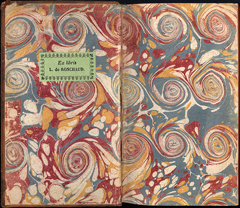|
References to paper marbling techniques are believed to be found as far back as the 10th century. In the 12th century, the Japanese art of Suminagashi, or "ink floating" was developed. Black and indigo ink would be dripped onto the surface of the water and then blown on to spread the ink into smoke-like patterns. Other artists would apply the sumi-ink to paper and then submerge it in water, creating patters as the ink lifted from the paper.
A separate arm of paper marbling (and the one from which Western marbling was born) is called Ebru or Turkish Marbling, and originated in the 15th century in Turkey, Persia, and India. The origin of the name is uncertain; it may come from "ebri" which means cloud, or "abru", which means water surface.
By thickening the water onto which the paint was placed, the artist was able to manipulate the paint on the water's surface, creating intricate, multicolored designs, which would then be transferred to paper. The style was passed down from mentor to apprentice, and though it originated as a decorative backdrop to written works, in time the paper became art in its own right.
By the 17th century, paper marbling gained recognition throughout Europe, and the beautiful papers were widely used as endpapers in hand-bound books. Despite the relative secrecy of the technique, in 1853, a book about Marbling was published, which diminished its esoteric nature.
Soon after, more books on the subject were published, and the style saw a surge of popularity until hand binding of books was replaced by binding machines. With this invention, paper marbling was largely forgotten in the Western world, though its popularity continued unabated in the East.
In the 1970s, some Western artists again began working in the style. This resurgence was due in part to artists seeking further afield for art forms, and in part to the growing popularity of handmade books.
The journal "Ink and Gall" was published in the USA from 1987 to 1993, and was dedicated to the process. The International Marbler's Gathering, sponsored by the publication, was first held in 1989 in New Mexico, and appears to still be an annual event.
|

A 1753 French book featuring marbled endpaper, likely shipped from Turkey or Persia.
|
